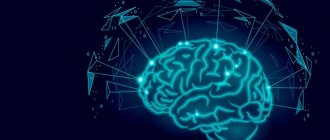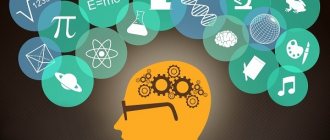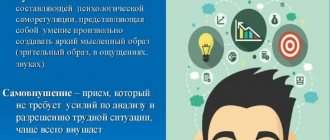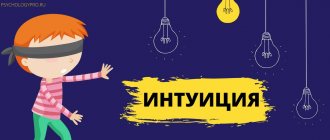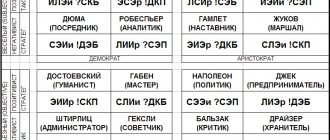If we analyze the work of a modern person with information, we can come to the conclusion that people remember most of the necessary information through repeated repetition, reading, and cramming. This kind of memorization takes a lot of time. There is a special type of memory - figurative memory. It is based on the sensations a person receives from the senses (images).
Images in memory
Figurative memory in psychology
Figurative memory is natural memorization. After listening to information once, a person will remember 10% of what was said. If an individual reads a text once, he will remember 30% of the information. If a person listens and reads this text at the same time, he will remember half of the information contained in it. If he had the opportunity to use the other senses, then after a single acquaintance with the text the individual would be able to reproduce it practically without loss.
Figurative memory is a persistent mnemonic form that is based on a person’s interests and knowledge. Images are inseparable from the consciousness of the individual. An example of figurative memory is the smell of tangerines, which people associate with the approaching New Year.
Attention! All babies have a well-developed figurative memory from birth.
But adults force them to memorize material, abstracting from sensations, so they lose it.
Photographic memory
As you have already learned, figurative memory includes any memory associated with the senses, since all such information does not come in the form of specific data, but in the form of abstract images. But at the same time, I would like to separately highlight photographic memory, which most likely every person has heard about.
Photographic memory is a subtype of visual figurative memory, but is distinguished by its incredible detail, which is unusual for most people, and the complete absence of pallor and clarity. What does it mean? Imagine how figurative memory works, it was described above. You look at an object and your brain takes a “snapshot” of that object, recording it in your brain. But this photo is initially blurry, and you are unlikely to be able to see all the details in it to reproduce them. If you have a photographic memory, then your brain can take perfect pictures that you can store for a long time without any loss in quality. Naturally, every person would like to have a photographic memory, however, given the fact that many parents do not strive to develop figurative memory in children, and also do not develop their own memory, this concept is now perceived more as a phenomenon than as something to what you can strive for and what you can achieve. But in reality this is not so, and you can independently change the order of things.
Why does a person need
Eidetic memory - what does it mean in psychology, examples
Figurative memory is an alternative to the principle “Repetition is the mother of learning” because it:
- Forms a holistic image, recreating missing sensations;
- Activates all channels of perception;
- Increases self-confidence, helping to remember information without stress, maintains mental health;
- Transforms mental activity into creativity;
- Frees up time for something more useful than repeatedly repeating what you need to remember;
- Reduces learning to understanding;
- Allows a person to do several things at the same time;
- Increases the pace of work;
- Can reconstruct any picture after a quick glance at it;
- Increases the amount of information that a person is able to retain in consciousness;
- Makes the process of forgetting arbitrary.
Important! Images return to an adult a child’s perception of the world and natural memory.
Children's perception of the world
Peculiarities
Long-term memory - what does it mean in psychology, how to improve it
Distinctive features of figurative memory are:
- Temporary storage of images. The necessary images are saved for a long time, and the unnecessary ones are erased after a day.
- The longer the image is stored, the paler it becomes. After a long period of time, it will be difficult for a person to remember the smallest details of the image.
- Unconscious nature. A person does not need to make an effort to remember something.
Fading images
What this is cannot be demonstrated clearly. Figurative memory is an abstract concept and all processes occur in your brain, but it is quite possible to describe what it is. So, imagine that you are traveling on public transport during the day. Returning home, you remember that you saw a woman in a blue coat, she was sitting next to you. At this point, you may remember other details such as the color of her hair, her facial features, the accessories she wore, and so on. But if you don’t think about it for at least a day, then the next day you will have difficulty remembering those details that seemed obvious to you yesterday. What can we say about what will happen in a week or month. Figurative memory is different in that the images stored in the brain become pale and fuzzy over time. They are unstable and may be fragmentary. For example, in a month you will forget what the girl was wearing in principle, but the earrings that she wore then will be imprinted in your brain. And of course, it is worth noting that each image can deceptively change over time and after a month it may seem to you that the girl was wearing a green coat, although in fact she was wearing a blue one. This is explained by the fact that it is easier for the human consciousness to create something new to replace the lost element of the image than to waste energy on remembering this element.
What is “vivid” figurative memory?
Vivid figurative memory is called eidetic. It is of an emotional nature. Preschoolers have this type of memorization. They can easily describe a friend’s favorite toy when it is no longer in sight, because the vivid image is imprinted in the brain and is of interest to them.
When reciting a long poem by heart, schoolchildren's eyes move as if a book with it was open in front of them. Their mind's eye actually sees the pages of the book where this poem is written. While telling it, they “see” all the drawings that were on this spread of the book.
Children gradually lose their eidetic ability when they enter school. Having mastered other methods of memorization, they less often turn to eidetics. It is replaced by abstract thinking.
Additional Information. Eidetic memorization is based on primary visual perception. It fully corresponds to the physiological development of preschool children and their inherent visual-figurative thinking. From the moment children enter school, verbal and logical thinking begins to actively develop, they learn definitions, rules, and draw conclusions, so eidetics and visual images give way to practical actions, logic and associative memorization.
Goals and objectives of the course
Not so far back in 2011, a study called “The Google Effect” was conducted at Columbia University, as a result of which scientists came to the conclusion that today people do not use their memory, because they always know that they can rely on the Internet. And this applies not only to some complex information, but even to the simplest things, for example, spelling rules.
And yet, a good memory is still necessary in life, work and learning. This fact is difficult to dispute, and it is unlikely that anything will change over the coming years. Based on this, we have developed our course that will help you :
| 1 | Better understand the information. Today, we are bombarded with streams of a wide variety of data from literally everywhere, in which it is easy to get confused. A good memory contributes to the development of the skill of identifying useful and necessary information and discarding everything unnecessary and unreliable. |
| 2 | Learn more effectively. An excellent memory will be useful in any field, regardless of whether you are in school, finishing graduate school or improving your qualifications. The more developed your ability to remember, the more you can know and put into practice, which in itself increases your effectiveness. |
| 3 | Develop thinking. The quality of thinking depends on the quantity and quality of neural connections in the brain. Constant perception, processing, memorization and reproduction of data have a beneficial effect on brain health, making the intellect more agile and alive. |
| 4 | Prevent diseases. As you know, with age, the human brain inevitably undergoes changes, as a result of which short-term memory deteriorates, cognitive abilities decrease, and dangerous illnesses such as Alzheimer's disease develop. Regular memory development exercises help you avoid all this. |
| 5 | Remember more. This is the most obvious advantage of developed memory. However, thanks to it, you will be able not only to remember important information or books you read, but to retain bright moments of life, pleasant emotions and joyful impressions in your head for a long time, and at the same time they will “look” clearer than the coolest photographs. |
Without developed memory, a person simply will not be able to fully function in the world. Of course, you can be content with what you have now, but why not think ahead and work on your intelligence and development of your potential today? Believe me, the time and effort spent on harmonious development will pay off with interest!
Types of figurative memory
Types of figurative memory
In psychology, the following types of figurative memory are distinguished:
- Visual. This type of memorization is based on retaining the faces of loved ones, advertising posters, and landmarks in the mind.
- Auditory. From all the variety of sounds, this type of memory helps a person choose the important ones to remember: his mother’s voice, the sound of an approaching car, the melody of his favorite song.
- Tasty. This type of memory allows a person to retain long-term ideas about the taste of lemon, pepper, and strawberry.
- Olfactory. Thanks to this type of memory, when a person smells a fire, he dreams of being on a camping trip.
- Tactile. Touch and tactile sensations help a person remember events. People enjoy petting cats because they remember the pleasant softness of their fur.
When does imagery appear?
The ability to perceive images appears in a child during early childhood. At the age of 1.5-2 years, the baby is able to remember brief figurative information. It is from this moment that long-term memory begins to exist. The baby’s sufficiently developed brain allows him to build simple logical chains and formulate concepts based on images.
Important! Figurative memory is usually called the foundation of all other types of storing information in consciousness. With poorly developed figurative memory, the volume of other types of memory will be small.
How to develop figurative memory
Methods for developing figurative memory are called mnemonics. To improve figurative memorization, you can:
- Train in memorizing a sequence of geometric shapes, applying the method of associations to them. A square can be associated with a window, and a trapezoid with a skirt.
- You can practice memorizing a number of words that are not related to each other in meaning if you compose a story that contains all these words. In addition, you can try to imagine a drawing or picture where all the words that you need to remember will be present in the form of images. Psychologists say that if the picture is illogical and absurd, this will ensure that the image is firmly imprinted, since people tend to pay attention to the unusual. For example, to remember the words “upside down”, “house”, “loaf”, “tree”, “get”, “woman”, “boat”, “axe”, you can imagine an absurd picture: loaves grow on a tree so that they to get it, the woman stood on the stairs, the ax was drowning in the river, and the boat did not float on the grass.
Nonsense
- When memorizing foreign words, you can associate their sounds with Russian words, giving each an image. For example, the German word “Krawatte” (tie) is similar in sound and spelling to the Russian word “bed”. To remember it, you can imagine a tie with a crib pattern.
- If you need to remember a date, each number can be endowed with a vivid image in your imagination.
- When memorizing any information, you need to try to use all your senses. This will ensure quick memorization and long-term storage of information in memory.
Thus, figurative memory is based on the simultaneous work of both hemispheres. You can force the brain to work at full capacity if you stimulate the simultaneous operation of all analytical systems when perceiving information. In this case, a vivid image is formed in a person’s mind, which is imprinted for a long time without the application of mental effort.
Good memory
Workout
You can independently influence how developed your figurative memory is, even if your parents did not pay much attention to it as a child. To do this, you need to conduct daily training that will allow you to better remember images. How to do it? You need to memorize various images and then reproduce them. Exercises can be very varied. For example, it could be a series of pictures that you need to look at and remember the images, rather than trying to come up with verbal associations. Then you need to reproduce the order of these images. You can also memorize a picture and then try to reproduce as many details as possible. There are a wide variety of games that involve memorizing images, so this can also help you, and photographic memory may soon seem no longer an unattainable phenomenon.


